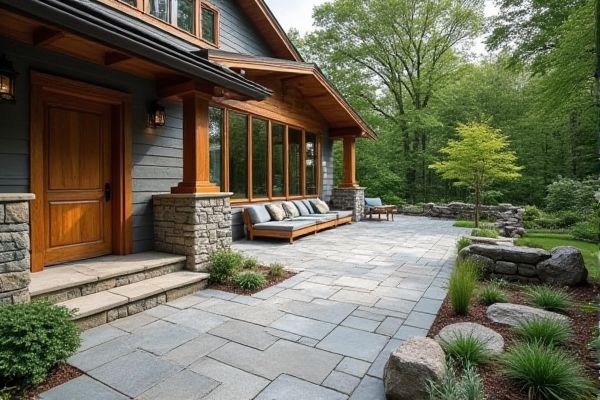
Concrete pavers offer a cost-effective, versatile solution with consistent shapes and colors, while natural stone provides a unique, durable aesthetic with varied textures and hues that enhance outdoor spaces. Explore the rest of the article to discover which option best suits your design goals and project needs.
Table of Comparison
| Feature | Concrete Pavers | Natural Stone |
|---|---|---|
| Material Composition | Man-made concrete mixed with cement, sand, and pigments | Natural quarried stone like granite, slate, or limestone |
| Cost | Lower cost; budget-friendly option | Higher cost; premium pricing |
| Durability | High durability; resistant to cracking and weathering | Very durable; natural strength varies by stone type |
| Appearance | Uniform colors and shapes; customizable patterns | Unique, natural textures and colors; organic look |
| Installation | Easy and quick installation | Complex; requires skilled labor |
| Maintenance | Low maintenance; occasional cleaning and sealing | Moderate; may require sealing to prevent stains |
| Environmental Impact | Manufacturing involves energy use and CO2 emissions | Natural resource extraction; less energy-intensive |
| Flexibility & Repair | Easy to replace individual pavers | Repairs can be difficult; slabs are heavier |
Introduction: Concrete Pavers vs Natural Stone
Concrete pavers offer affordability, uniformity, and ease of installation compared to the unique textures, colors, and durability of natural stone. Natural stone provides a timeless, elegant aesthetic with higher resistance to weathering, making it ideal for long-lasting outdoor spaces. Choosing between concrete pavers and natural stone depends on your budget, design preferences, and maintenance expectations.
Appearance and Aesthetic Appeal
Concrete pavers offer a wide range of customizable colors, shapes, and textures, allowing for versatile design options that mimic natural stone or create modern patterns. Natural stone provides unique, organic beauty with variations in color and texture that develop distinct character over time, enhancing outdoor spaces with timeless elegance. While concrete pavers deliver uniformity and lower initial cost, natural stone is prized for its authenticity and lasting aesthetic appeal in landscaping projects.
Durability and Lifespan
Concrete pavers offer exceptional durability with resistance to cracking, fading, and heavy loads, making them ideal for high-traffic areas. Natural stone provides a timeless aesthetic with a longer lifespan due to its inherent strength and weather resistance, often lasting over 50 years with proper maintenance. Your choice between concrete pavers and natural stone should consider the balance between initial cost, maintenance, and the desired longevity of your outdoor surface.
Installation Process
Concrete pavers offer a straightforward and efficient installation process, often requiring less time due to their uniform size and shape, which simplifies alignment and pattern creation. Natural stone installation demands more skill and labor because of irregular shapes and varying thicknesses that necessitate precise cutting and custom fitting. Both materials require a properly prepared base and adequate drainage to ensure longevity and prevent shifting.
Cost Comparison
Concrete pavers generally offer a more budget-friendly option compared to natural stone, with prices averaging $2 to $5 per square foot, while natural stone can range from $5 to $15 per square foot or more depending on the type and source. Installation costs for concrete pavers are often lower due to easier handling and faster placement, reducing labor expenses. Your project budget can stretch further with concrete pavers, but natural stone provides a unique, high-end aesthetic that may justify the higher investment.
Maintenance Requirements
Concrete pavers require less frequent sealing and are easier to clean with basic sweeping and occasional washing, making them low-maintenance compared to natural stone. Natural stone demands regular sealing to prevent staining and weather damage, along with more careful cleaning methods to avoid surface erosion. Choosing concrete pavers can simplify your maintenance routine without sacrificing durability.
Environmental Impact
Concrete pavers have a higher carbon footprint due to cement production, while natural stone offers greater sustainability with minimal processing and longer lifespan. Natural stone's extraction may cause localized habitat disruption, yet its durability reduces frequent replacements, conserving resources over time. Your eco-conscious choice depends on balancing initial environmental costs with long-term sustainability.
Versatility in Design
Concrete pavers offer exceptional versatility in design, available in a wide array of colors, shapes, and textures that can mimic natural stone or create bold, modern patterns. Natural stone provides unique, organic variations in color and texture, lending an authentic and timeless aesthetic that is difficult to replicate with manufactured materials. Both options allow for creative design flexibility, but concrete pavers excel in customization for uniformity and intricate layouts.
Safety and Surface Texture
Concrete pavers offer consistent surface texture with slip-resistant finishes that enhance safety in wet or icy conditions, making them ideal for high-traffic areas. Natural stone provides a unique, irregular surface that can be more slippery when polished or wet, requiring careful selection and maintenance for safe use. Both materials can be treated or finished to improve traction, but concrete pavers generally deliver more uniform safety performance.
Choosing the Right Material for Your Project
Concrete pavers offer versatility, affordability, and a wide range of colors and shapes, making them ideal for customizable designs and budget-friendly projects. Natural stone provides unmatched durability, unique textures, and a timeless aesthetic, often preferred for high-end landscaping and hardscaping. Evaluate factors such as project budget, design preferences, maintenance requirements, and climate resilience to select the optimal material for driveways, patios, or walkways.
 homyna.com
homyna.com